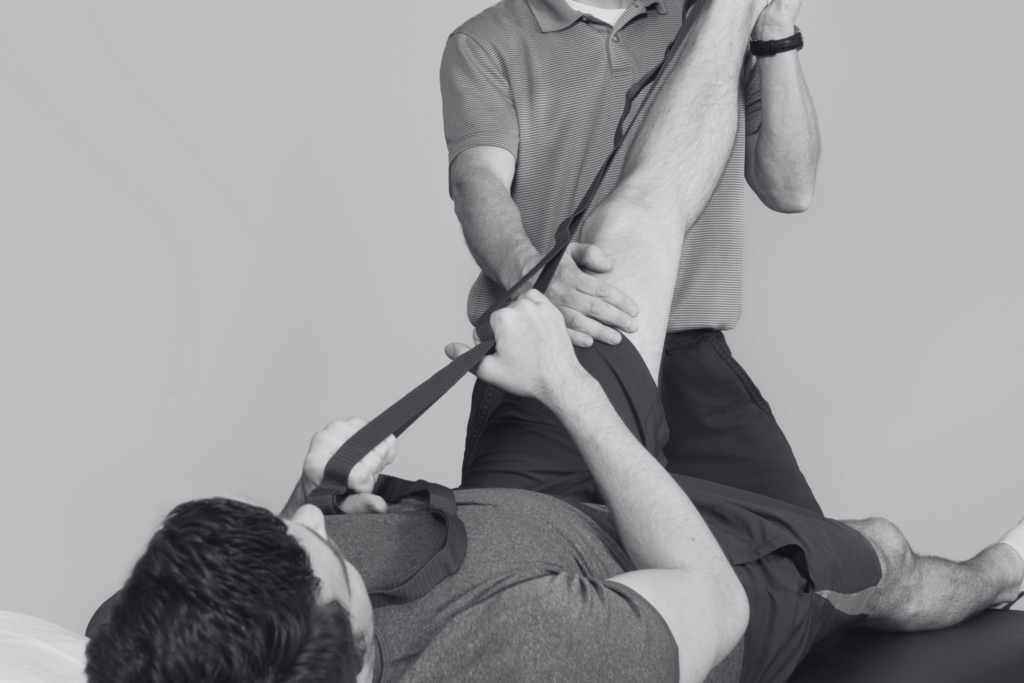Chiropractic vs Physiotherapy for Back Pain
Does Chiropractic work better than Physiotherapy for back pain? It depends!
Physiotherapy
- Physiotherapists use manual techniques like stretch, exercise, and soft-tissue work to improve function, reduce pain and rehabilitate injuries.

Chiropractic
- Chiropractors adjust the spine and other joints to relieve painful restrictions – improve mobility, and reduce muscle tension and spasms.
Back pain can have many causes, so the right treatment will be different for each person. In this article, we discuss some common causes of back pain and their treatment options, to help you decide whether to start with an Assessment by a Chiropractor or a Physiotherapist to help relieve your pain and stiffness.
Back pain can creep on gradually or start with almost no warning. No matter the cause or mechanism of onset, back pain can be debilitating and take us away from the things we love to do. When back pain starts, it can be hard to do anything, and just performing regular daily activities (like dressing, preparing meals, and working) can be troublesome. Without a proper assessment to determine the cause of your pain, it can be hard to know whether to rest or stretch, use heat or ice packs, or even if it’s safe to exercise. Our experts at Anatomica can help get you feeling like yourself again.

When determining whether to see a Chiropractor or Physiotherapist for back pain, we often start by categorizing the injury into one of two main types: sudden-onset back pain, and gradual-onset back pain.
Sudden-Onset Back Pain
Some causes of sudden-onset back pain can include injuries to the intervertebral discs, severe muscle spasms, or ligament tears, contusions and fractures from falling, whiplash injuries, and other traumas. Sudden-onset back pain tends to be acute, and severely impacts functional mobility or disrupts daily activities. Sudden-onset back pain can start without a traumatic event, commonly happening from a combination of bending, lifting, and twisting actions or other unpracticed movement pattern.
Sudden-onset back pain needs careful assessment to determine the potential level and severity of injury. A strong knowledge of anatomy, biomechanics, and neurology is important to assess sudden-onset back injuries, especially if there is any radiating pain, restricted movement, or altered sensations like burning, tingling, or numbness present. Chiropractors are experts in the spinal column and nervous system, and for this reason we often recommend Chiropractic care as a starting point for patients who have severe, sudden-onset back pain. Assessment may include physical testing, manual palpation, neurological and functional abilities screenings, and referral for x-rays if necessary.
Gradual-Onset Back Pain
Some causes of gradual-onset back pain can include functional limitations, mechanical or postural dysfunctions, overuse injuries, and chronic injuries. Gradual-onset back pain tends to be harder for the patient to pinpoint, and may not always feel the same — it’s often affected by certain specific activities.
Gradual-onset back pain can feel like a dull ache or be nagging, and is often worse at the end of the day or exercise. Chronic back pain can also linger after an acute or sudden injury if it heals improperly, and may be similar but not identical to the previous injury. This type of back pain is often caused by an imbalance of strength or mobility, or maladaptive movement patterns. Physiotherapists are experts in form and function, and we generally recommend that patients start with a Physiotherapy Assessment for chronic or gradual-onset back pain. A functional assessment including muscle length and strength tests, movement, and mobility is required to find the cause, and may include focus to the feet, ankles, knees, and hips for a greater overall sense of biomechanics.
When to choose Chiropractic vs Physiotherapy for Back Pain:
| Physiotherapy | Chiropractic | |
| Sudden-Onset Back Pain | X | |
| Gradual-Onset or Chronic Back Pain | X | |
| Dull, aching, or nagging pain | X | |
| Back pain with other joint injury or pain (hip, knee, ankle) | X | |
| Back pain with prolonged sitting or inactivity | X | |
| Sharp, shooting, or electric pain | X | |
| Back pain that radiates (travels) into arms, legs, or buttock | x | |
| Back pain with tension headaches, migraines, or TMJ | X | |
| Altered sensation, numbness or tingling | X | |
| Pain that is worse during or after specific activities/exercise | X | |
| Pain that is constant, with little relief even after resting | X | |
| Pain in an area that was previously injured | X | X |

Can I see a Physiotherapist and a Chiropractor at the same time?
Yes! In fact, combining active rehabilitation with adjustments and manual therapy actually increases the effectiveness. Studies show that when patients receive integrated, multidisciplinary treatment like we offer at Anatomica, they recover faster. [1,2,3] Here are just some of the modalities used by our Physiotherapy and ,Chiropractic team to treat different forms of acute and chronic back pain:
,



Back pain is not a normal sign of aging! You deserve to live pain-free.
Read what real patients are saying about Anatomica:
My sister recommended Jake Head for physiotherapy and I am so glad that I booked with Jake! He is incredibly knowledgeable and really takes the time to listen to the problems. In my case, it turned out that one of the problems that I thought I had wasn’t a problem but then something else was (and I didn’t even know it was a problem). I really like his long-term and active therapy approach where he empowers you with the knowledge to correct the problem and to set you up for a healthy life.
— C.C., Google Review
Care, dedication, knowledge, professionalism. I’ve moved to the east end and still come back to Anatomica.
— G.M., Google Review
Had a great assessment and session with Dr. Jeff Belgue today. I was able to find a time on the holiday Monday and schedule the session in less than 48 hrs. Very useful online booking software that enabled me to provide all historical notes leading up to the session. Jeff had read all of the notes ahead of the session, asked a few clarifying questions and then took me through a range of tests. It was a great visit and Jeff has a strong background in kinesiology, biomechanics and treatment / care. Thank you for helping with my back pain!
— P.S., Google Review
- Geisser ME, Wiggert EA, Haig AJ, Colwell MO. A randomized, controlled trial of manual therapy and specific adjuvant exercise for chronic low back pain. Clinical Journal of Pain. 2005;21:463–470. doi: 10.1097/01.ajp.0000135237.89834.23. [PMC free article] [PubMed] [CrossRef] [Google Scholar]
- UK BEAM Trial Team United Kingdom back pain exercise and manipulation (UK BEAM) randomised trial: effectiveness of physical treatments for back pain in primary care. British Medical Journal. 2004;329:1377–1381. doi: 10.1136/bmj.38282.669225.AE. [PMC free article] [PubMed] [CrossRef] [Google Scholar]
- UK BEAM Trial Team UK back pain exercise and manipulation (UK BEAM) trial – national randomised trial of physical treatments for back pain in primary care: objectives, design and interventions. BioMed Central Health Services Research. 2003;3:16. doi: 10.1186/1472-6963-3-16. [PMC free article] [PubMed] [Google Scholar]

